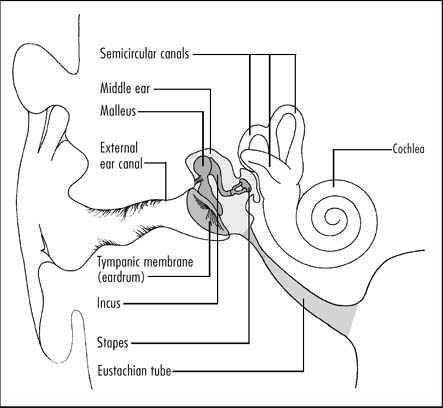Otitis media
Inflammation of the middle ear, otitis media may be suppurative or secretory, acute or chronic. Acute otitis media is common in children; its incidence rises during the winter months, paralleling the seasonal rise in nonbacterial respiratory tract infections.
With prompt treatment, the prognosis for acute otitis media is excellent; however, prolonged accumulation of fluid within the middle ear cavity causes chronic otitis media, with possible perforation of the tympanic membrane. Chronic suppurative otitis media may lead to scarring, adhesions, and severe structural or functional ear damage; chronic secretory otitis media, with its persistent inflammation and pressure, may cause conductive hearing loss.
Causes
Otitis media results from disruption of eustachian tube patency. (See Sites of otitis media.)
Suppurative otitis media
In the suppurative form, respiratory tract infection, allergic reaction, nasotracheal intubation, or positional changes allow nasopharyngeal flora to reflux through the eustachian tube and colonize the middle ear. Suppurative otitis media usually results from bacterial infection with pneumococci, Haemophilus influenzae (the most common cause in children younger than age 6), Moraxella catarrhalis, beta-hemolytic streptococci, staphylococci (most common cause in children age 6 or older), or gram-negative bacteria.
Predisposing factors include genetic factors, such as susceptibility to infection; the normally wider, shorter, more horizontal eustachian tubes and increased lymphoid tissue in children; and anatomic anomalies. Chronic suppurative otitis media results from inadequate treatment of acute otitis episodes or from infection by resistant strains of bacteria or, rarely, tuberculosis.
Secretory otitis media
With secretory otitis media, obstruction of the eustachian tube causes a buildup of negative pressure in the middle ear that promotes transudation of sterile serous fluid from blood vessels in the membrane of the middle ear. Such effusion may be secondary to eustachian tube dysfunction from viral infection or allergy. It may also follow barotrauma (pressure injury caused by inability to equalize pressures between the environment and the middle ear), as can occur during rapid aircraft descent in a person with an upper respiratory tract infection or during rapid underwater ascent in scuba diving (barotitis media).
Signs and symptoms
Signs and symptoms vary with the specific type of the disorder.
Suppurative otitis media
Stay updated, free articles. Join our Telegram channel

Full access? Get Clinical Tree



